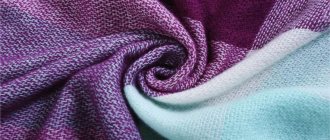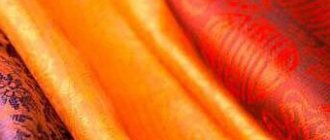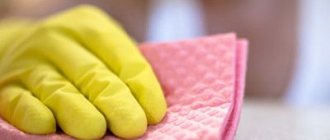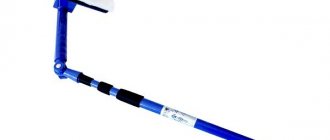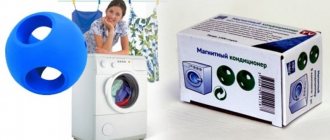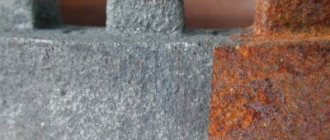What is this text about? In this text we will answer the following questions: which insulation is better polyester or down insulation 100 polyester what does it mean insulation 100 polyester what is it Polyester: is it warm in winter, and what temperatures is it designed for?
Polyester is a synthetic textile product made from polyester fiber. This can be a thin fabric from which summer and sportswear is sewn, or a non-woven fabric used as insulation in the manufacture of jackets and coats. Products made from this durable and inexpensive material account for more than half of the volume of the modern textile market. High-quality polyester is produced using the latest equipment and is quite capable of competing with natural materials. Clothing with polyester filling is relevant both in autumn bad weather and in winter cold.
Features of modern polyester
Until recently, it was believed that clothing with synthetic insulation was in many ways inferior to products made from natural materials. The consumer's skepticism was well founded. After all, the polyester produced in the past easily wrinkled and caked, causing the product to lose its shape. In addition, the insulation quickly lost its thermal insulation qualities, and after the first wash the item became completely unusable.
The low quality of the material and the inability of the insulation to meet its intended purpose was explained by the structure of the material.
- In the past, polyester fiber was produced in the form of straight threads and placed in the same plane.
- Now polyester consists of fibers twisted into spirals, balls and tubes, inside of which there are air pockets.
Modern polyester is a light and warm material that perfectly copes with the role of insulation for demi-season and winter clothing.
It is impossible to unequivocally answer the question of what temperature a synthetic filler is designed for. After all, the name “100% polyester” can hide Thinsulate, Holofiber, Sintepon, Isosoft and other materials based on polyester fiber. All of them have a certain density and structure, and therefore thermal conductivity.
Description of material, cost, composition
Now a little more about polyester, what kind of material it is, is it warm or not and in what form is it produced. To put it in simple words, it is an accumulation of polyethylene fibers, solid or hollow, loosely fastened together. Due to this looseness, many cavities filled with air are formed in the thickness of the insulation. The number of cavities, in turn, depends on the thickness of the insulation and the diameter of the fibers from which it consists. And the more air there is in the thickness of the layer, the more heat it will retain.
Insulation materials made from polyester can be divided into two types:
- Volumetric fillers, the number of air cavities in which increases due to the thickness of the material itself. The most budget option is padding polyester. Its initial cost is less than 200 rubles. per linear meter. More expensive, but better - Thinsulate, from 450 rubles. per linear meter.
- Thin-layer materials, where the small thickness of the filler is compensated by the small thickness of the fibers, which provides a sufficient number of air cavities in the layer. The cheapest variety is polyester fleece. It will cost you from 250 rubles. for 1 meter. There is also a more advanced version, depending on the manufacturer, such a canvas can cost from 350 (Korean) to 2500 rubles (original, produced by Polartec® LLC).
The composition of the fillers - insulation in question - is 100% polyester, or the same, but with a small inclusion of other fibers.
Advantages and disadvantages of polyester insulation
The properties of polyester, its many advantages and some disadvantages are determined by the structure of the polyester fiber, the method of weaving the threads and various additives. Here is a list of the main positive qualities of insulation made from this material:
- Outerwear insulated with polyester can serve at air temperatures from -5 °C to -30 °C.
- Synthetic filler does not contribute to the emergence and development of pathogenic microflora, so things with polyester can be worn by people suffering from allergies.
- The unique formula of polyester fiber allows the product to retain its original shape for a long time. Things do not deform even after frequent washing.
- Clothes filled with polyester do not require special care. It is easily machine and hand washable.
- Coats and jackets filled with polyester fiber are lightweight. Both adults and children are comfortable in such clothes.
Speaking about the disadvantages of this material, the following should be noted:
- When heated to temperatures above +40 °C, the filler may become deformed.
- Cheap types of material fall off and form clumps after several washes.
- Clothes do not allow air to pass through well.
- Insulation is destroyed under the influence of gasoline, acetone, benzene and other aggressive chemicals.
When producing high-quality polyester filler, the thermal method is usually used to join the layers. However, in the production of some cheap varieties of this material, for example, padding polyester, gluing with special adhesives is acceptable. Such fillers are hazardous to health as they can cause allergic reactions. When choosing clothes with synthetic filling, you need to pay attention not only to the thickness of the lining, but also to the method of making the insulation.
Types of fillings in jackets
What is polyester in a jacket? When buying a coat or other outerwear, people primarily focus on the weather and climate of their region. But this may not be enough, because polyester in jackets has different properties. You can ask a store consultant for more information about padding. Information about this is indicated on the tag. There are fillers that are easy to distinguish by tactile sensations (for example, padding polyester).
Thinsulate
Down of artificial origin, which in its properties differs little from natural fluff. Thinsulate was used to insulate astronaut suits. Today they are used to stuff winter clothes for sailors and sleeping bags for mountaineers. To what temperature is polyester suitable? Things insulated with Thinsulate can be worn at 30-60 degrees below zero. It all depends on how dense the layer is. The stuffing is suitable for sewing children's clothes. Thinsulate fiber produces lightweight and at the same time warm clothing that is highly breathable.
Its density is 100-480 g/m². Due to its softness and light weight, Thinsulate is in many ways similar to swan's down. It is in many ways identical to natural, but does not cause allergies. Thinsulate consists of microfibers that are surrounded by air membranes. This polyester insulation is thin enough, so you can sew elegant winter coats from it. Things made from this filler have one drawback - the high price.
Holofiber
Holofiber does not absorb moisture, as it quickly evaporates from it. At the same time, warmth can be retained in clothing. There are halofiber balls inside the outer sides of the material. This polyester jacket will keep you from freezing and sweating. The raw materials are used to sew children's clothes. It is safe for allergy sufferers and suitable for everyone. The properties of holofiber largely imitate down. It can withstand machine washing on a delicate cycle.
The density of the material ranges from 70 to 300 g/m². How many degrees is holofiber suitable for? It is recommended to wear it at temperatures from 5 degrees Celsius to 30 degrees below zero. It is wear-resistant and does not lose its thermal insulation properties for a long time. Winter jackets made from holofiber can be worn in low temperatures and strong gusts of wind.
Sintepon
At one time, the structure of this material was changed, and since then it has been used in the production of jackets and coats. Sintepon 150 g/m² is the minimum density of the material, the highest is 400 g/m². It perfectly retains its shape and retains heat; items made from it are sold at reasonable prices. Many people are interested in what temperature is a padding polyester 200 g m2 designed for? It is recommended to wear things with such padding at the end of autumn or at the very beginning of winter, if the temperature has not dropped to 10 degrees below zero. Things that can be worn at 25 degrees below zero are insulated with padding polyester with a density of 350 g per m².
Sintepooh
This polyester insulation is reminiscent of bird down in its properties. The polyester fiber in it is glued in it in a special way. Synthetic fluff is wear-resistant, does not wrinkle, and dries quickly. For the winter months, when the temperature drops to 25 degrees, you can wear jackets with synthetic down, the density of which is 250 g/m². In five-degree frost, a filler with a density of 60 g/m² is sufficient. According to its structure, such polyester insulation can be homogeneous or elastic.
Isosoft
This material comes in different types. One of them is isosoft, the fibers of which are made in the form of balls. It is easy to care for: after washing it dries quickly and is not subject to deformation in the machine. Isosoft is thin enough, so down jackets made from it do not look bulky. Density ranges from 80 to 300 g/m². At the same time, the layer retains heat well. It is several times better than synthetic winterizer in its thermal insulation properties.
Isosoft is very soft and elastic, wear-resistant and at the same time breathable. A relatively thin layer of isosoft will prevent you from freezing in frosty weather. You can wear a coat with this insulation both in winter and in the off-season.
Manufacturers advise you to find out the density of isosoft and at what temperature it can be worn:
To improve the thermal insulation characteristics of isosoft, you need to put something thick under your coat (for example, a fleece sweater). This is how you can insulate a demi-season down jacket made of isosoft if the weather unexpectedly changed on a trip and you didn’t have any warmer things with you.
Certain types of polyester linings are suitable for different temperatures and weather. When purchasing items with synthetic padding, it is worth asking a consultant about how and what the interlayer is made of, what its density is, as well as other properties.
Experts advise asking what brand of outerwear is and reading reviews. The main thing is to know at what temperature you can wear it, what the density is, whether it can withstand machine washing and what the quality of the layer is.
Source
Thinsulate
Of all the insulation materials made from polyester fiber, Thinsulate is the lightest and warmest. No wonder it is compared to natural swan down. This artificially created material has all the positive qualities of down and at the same time is devoid of its disadvantages.
Thinsulate, consisting of microscopic fibers surrounded by an air shell, is capable of retaining heat and warming the human body at temperatures as low as -60 °C. Moreover, the insulation is not too thick, and the clothes turn out to be light and not bulky.
This material is used to make warm clothes for polar explorers and oil workers, and sew comfortable equipment for climbers. The only drawback of clothes filled with Thinsulate is the high cost.
Where is it used?
Polyester filler is used in many areas:
- insulation of houses; car seat filling; insulation of sports items, outerwear; making quilted lining; the inside of pillows, blankets; filling soft toys, sides of cribs; production of thermal underwear, sleeping bags; making the insides of autumn and winter boots.
Various materials are made from polyester fibers. They are becoming more and more popular.
Lining fabric
Polyester lining material is used for the following products:
- trousers, dresses, skirts, suits; jackets, jackets, coats; winter jackets and overalls.
The polyester lining does not wrinkle or stretch, and remains in its original form for a long time. It does not allow moisture and heat to pass through. Winter polyester lining fabrics are supplemented with thermal protection.
Holofiber
This type of synthetic insulation is a non-woven polyester fiber made in the form of balls or springs, interconnected under the influence of high temperatures. The material has good breathability, easily restores its shape after compression and is capable of warming at air temperatures down to -30 ° C.
Textile factories produce holofiber of various densities. The thermal conductivity of the material depends on this indicator:
- If the density of holofiber is no more than 80 g/m², then a jacket with such insulation is only suitable for autumn weather.
- At air temperatures above -10 °C, clothing with a filling density of 150 g/m² is suitable.
- To use the product in severe frosts, the density of the insulation should be 300 g/m².
Rules of care
Care instructions for washing and drying:
- We recommend hand washing or a suitable machine wash cycle. A polite program is suitable.
- The water temperature is not higher than 40 degrees. Spin speed up to 800.
- First of all, use air conditioning. Heavily soiled items are treated with stain remover and soaked before washing. Do not use chemical bleaches.
- Dry in a room with excellent ventilation. Do not hang the product in direct sunlight. Clothes are hung on hangers away from appliances with heating functions.
- Iron in case of urgent need, at low temperature, through a piece of dry cloth. Use the steamer very carefully, if the instructions on the tag allow it.
Polyester fibers should not be exposed to high temperatures or boiling. This spoils the structure of the fabric and changes the shape of the item.
Is a jacket with polyester filling warm during winter? Yes, if you choose a good thing and take care of it correctly. The product will heat for a couple more seasons.
Elena, 47 years old, Novosibirsk: at an early age she wore a jacket with padding polyester. A very large thing that is uncomfortable to move in and not always warm. At the moment I am purchasing it with holofiber and I feel very good.
Anna, 23 years old, Moscow: I love extreme recreation; a year earlier I bought a winter suit made of Thinsulate. Nothing has ever been so warm!
Sergey, 31 years old, Vladivostok: I won’t say that holofiber or isosoft are bad, but I prefer to use natural materials as much as possible, like the filling in a down jacket.
Vladimir, 40 years old, Samara: I’m not very cold, in most cases I buy a cheap jacket with padding polyester. I feel good.
news feed
- 20:01 Signs for August 24: what not to do on Evpatiy Day
- 19:26Social networks: Lukashenko was evacuated by helicopter
- 18:00What happened today: latest news for August 23
- 17:42Horoscope for August 24, 2022
- 17:35Media: Kim Jong-un is in a coma
- 17:00They only need blood: Lavrov spoke about the Belarusian opposition who fled to the West
- 16:17The new Tu-95MSM missile carrier flew for the first time - video
- 15:59Utyasheva in a bikini leaned on a rock
- 15:19Like milk mushrooms: an unusual recipe for pickled zucchini
- 15:09 “We feel like pioneers”: the pilot was amazed at the capabilities of the Su-57
- 14:44The army will fight back: Minsk warned Belarusians against unrest
- 14:10Guzeeva harshly scolded her daughter before the wedding
- 14:08 “Guest of the Chancellor”: Navalny was given special status after his flight to Germany
- 13:47Tanks and planes: Lukashenko was told about possible preparations for his overthrow
- 13:11Russia will send a second batch of S-400s to Turkey
- 12:56It will last until spring: how to feed cabbage at the end of August
- 12:21 “Mom’s pride”: Orbakaite’s daughter took up aerial gymnastics
- 12:19Serious condition: Yulia Tymoshenko became infected with coronavirus
- 12:00Torn to pieces: expert proved the Netherlands was lying in the MH17 case
- 11:44 “They invited me to see a disabled person!”: the star was furious with Korchevnikov
- 11:15Coronavirus in Russia: the main thing
- 11:10 “Genius of geopolitics”: Skabeeva reprimanded Zelensky after Lukashenko’s advice on elections
- 11:07Former Rada deputy revealed the main threat to Moscow in the “poisoning” of Navalny
- 10:47 Latest statistics on coronavirus in Russia as of August 23
- 10:34Ukraine has come up with a new strategy for the “return” of Crimea
- 10:31 “Wake up!”: Solovyov publicly had a row with Efremov’s ex-lawyer
- 09:30Gardening calendar for August 23, 2020
- 07:10Funny jokes for August 23
- 04:00New information has appeared about the son of Friska and Shepelev
- 01:04Gordon divorced his wife
- 22:04Cucumbers without sterilization: a simple recipe for the winter
- 20:00 Signs for August 23: what not to do on Laurentian Day
- 19:00What happened today: latest news for August 22
- 18:00Horoscope for August 23, 2022
- 17:23Ukraine created a scandal with Finland over Crimea
- 16:58 “No words”: cancer patient Shura shocked fans with his appearance
- 16:11 Putin’s “golden” strategy has attracted admiration in Europe
- 15:39Answer to Putin: striking enterprises in Belarus are closing
- 15:14I was depressed and drank every day: the version of Navalny’s poisoning was denied
- 14:35 “Not human”: the disappearance of Easy-Stupa’s coffin after the funeral was explained
- 14:14 Norkin, who lost his wife, spoke about “chicks”: fans are unhappy
- 13:41Czech media: Russia can covertly help Lukashenko in the fight against protests
- 13:31 “It’s like I didn’t have time to wash my hair”: a Hollywood stylist spoke harshly about Rotaru’s appearance
- 12:56Zelensky understands this: Russia has assessed the likelihood of Ukraine’s annexation due to Crimea
- 12:44The Germans revealed details of Navalny’s condition
- 12:31 “Perfect couple”: Kharlamov showed his children from Guzeeva
- 12:21 “It’s painful to watch”: eyewitnesses spoke about the condition of Korchevnikov, who underwent surgery
- 11:49Now homeless: Lolita gave her last “gift” to her ex-husband
- 11:48Lukashenko decided to take tough measures in Belarus
- 11:26Ukrainian intelligence was ridiculed for being a secret agent who was “burned dozens of times”
Distinctive features
- Classification of material . Polyester is a woven material from which clothing and other products are made. Sintepon is a filler necessary for stuffing various objects and things. The products have different structures, and this is their main difference. Sometimes, padding polyester is made in flat sheets, but this form is not a fabric.
- Manufacturing technology . The woven product is produced by weaving synthetic fibers. The individual elements form a single canvas. The filler is also made from synthetic raw materials, but for this purpose, the fibers are connected to each other with an adhesive base.
- Scope of application . Polyester can be combined with padding polyester. Their combined use is only in winter clothing. The fabric can be used to produce summer textiles, curtains, tulle, tablecloths and other lightweight items. The filler is used to create mattresses, children's toys, and briefcases (to reduce the load on the back and shoulders).
- Color palette . Since padding polyester is not visible when wearing or using things made from it, it does not need aesthetic qualities. The filler is made in white - the most neutral color. According to its characteristics, the fabric should have a variety of colors so that there is a choice for an individual case. Unlike natural products, synthetics have a wider palette of shades. You can get rich, bright colors.
